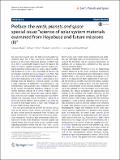| dc.contributor.author | Okada, Tatsuaki | |
| dc.contributor.author | Connolly, Harold C | |
| dc.contributor.author | Yada, Toru | |
| dc.contributor.author | Ohtsuki, Keiji | |
| dc.contributor.author | Connolly, Harold C. | |
| dc.contributor.author | Binzel, Richard P | |
| dc.date.accessioned | 2017-03-16T19:28:56Z | |
| dc.date.available | 2017-03-16T19:28:56Z | |
| dc.date.issued | 2017-02 | |
| dc.date.submitted | 2017-02 | |
| dc.identifier.issn | 1880-5981 | |
| dc.identifier.issn | 1343-8832 | |
| dc.identifier.uri | http://hdl.handle.net/1721.1/107442 | |
| dc.description.abstract | Six years have passed since the first asteroid sample was returned from the S-type near-Earth asteroid 25143 Itokawa by the JAXA’s Hayabusa mission in 2010 (Yada et al. 2014). Considerable progress has been made in the study of surface regolith materials and the understanding of planetary surface processes such as space weathering (Noguchi et al. 2011), the chronology of Itokawa and its dynamic evolution processes (Nagao et al. 2011; Park et al. 2015), and the thermal alteration undergone in parent bodies (Nakamura T et al. 2011). Discussions of new findings from the Hayabusa-returned samples and from a large collection of meteorites, micrometeorites, and interplanetary dust particles have continued, especially at the annual international Hayabusa symposia of solar system materials (Okada et al. 2015). Progress in sample return science has driven the next stage of exploration. Now, two new sample return missions to primitive, volatile-rich asteroids, JAXA’s Hayabusa2 (Tsuda et al. 2013) and NASA’s OSIRIS-REx (Lauretta et al. 2012), are en route to their target bodies, C-type 162173 Ryugu and B-type 101955 Bennu, respectively.
It is our great pleasure to present our second special issue of the journal Earth, Planets and Space, “Science of solar system materials examined from Hayabusa and future missions (II).” This special issue is based on discussions during the Hayabusa 2014 symposium, which featured new results from Hayabusa-returned samples and related studies, but was also open to any scientific results regarding primitive bodies and the early solar system, the results of laboratory experiments and ground-based observations, and reports of new instruments and methods. We will begin with a brief introduction to the missions of the Hayabusa and its successor Hayabusa2. In addition, all six manuscripts published in this special issue are reviewed below. | en_US |
| dc.publisher | Springer Berlin Heidelberg | en_US |
| dc.relation.isversionof | http://dx.doi.org/10.1186/s40623-017-0617-3 | en_US |
| dc.rights | Creative Commons Attribution | en_US |
| dc.rights.uri | http://creativecommons.org/licenses/by/4.0/ | en_US |
| dc.source | Springer Berlin Heidelberg | en_US |
| dc.title | Preface: the earth, planets and space special issue: “science of solar system materials examined from Hayabusa and future missions (II)” | en_US |
| dc.title.alternative | Special issue “Science of solar system materials examined from Hayabusa and future missions (II)” | en_US |
| dc.type | Article | en_US |
| dc.identifier.citation | Okada, Tatsuaki et al. “Special Issue ‘Science of Solar System Materials Examined from Hayabusa and Future Missions (II).’” Earth, Planets and Space 69.1 (2017): n. pag. | en_US |
| dc.contributor.department | Massachusetts Institute of Technology. Department of Earth, Atmospheric, and Planetary Sciences | en_US |
| dc.contributor.mitauthor | Binzel, Richard P | |
| dc.relation.journal | Earth, Planets and Space | en_US |
| dc.eprint.version | Final published version | en_US |
| dc.type.uri | http://purl.org/eprint/type/JournalArticle | en_US |
| eprint.status | http://purl.org/eprint/status/PeerReviewed | en_US |
| dc.date.updated | 2017-02-14T04:33:42Z | |
| dc.language.rfc3066 | en | |
| dc.rights.holder | The Author(s) | |
| dspace.orderedauthors | Okada, Tatsuaki; Binzel, Richard P.; Connolly, Harold C.; Yada, Toru; Ohtsuki, Keiji | en_US |
| dspace.embargo.terms | N | en_US |
| mit.license | PUBLISHER_CC | en_US |
